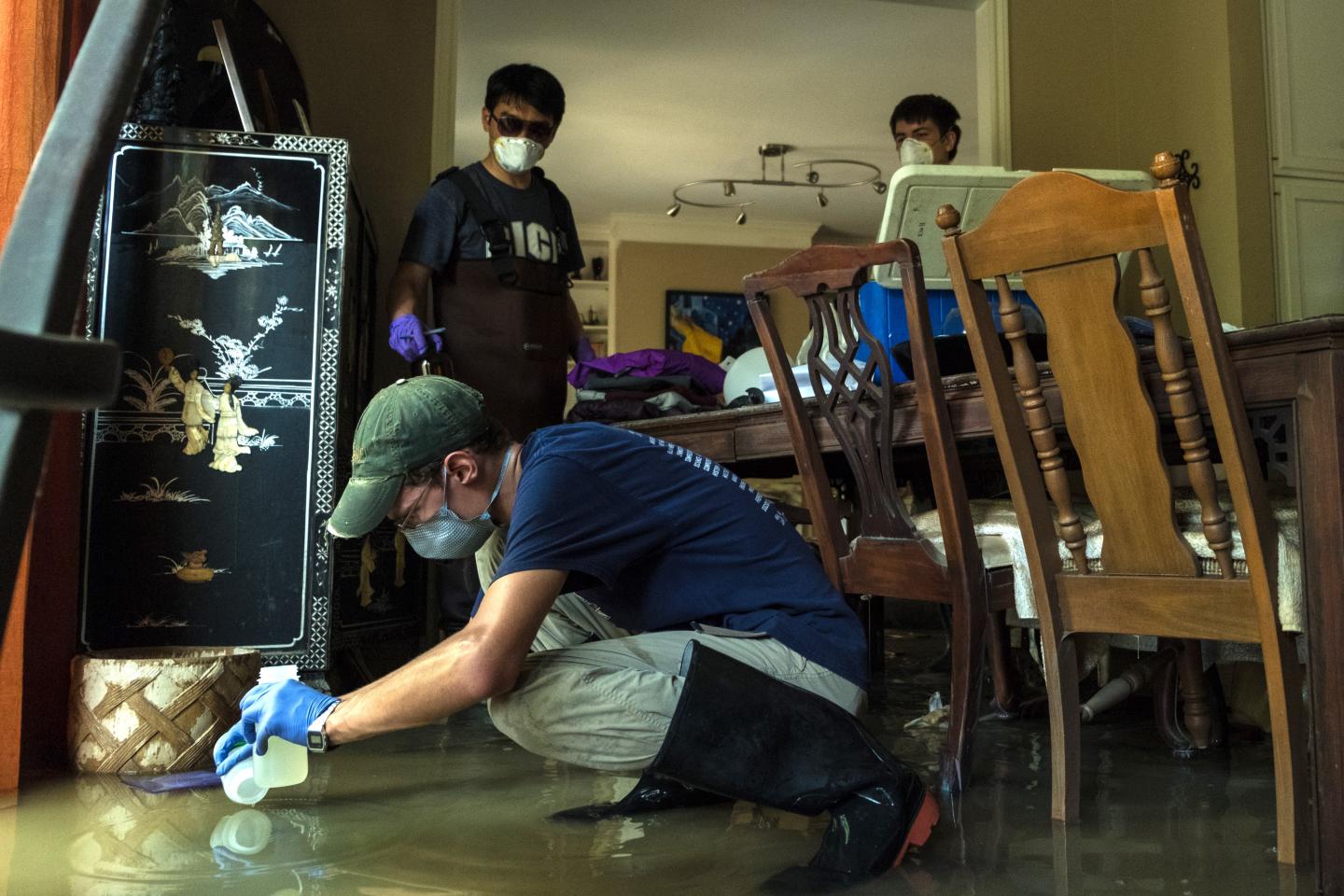
Credit: Jeff Fitlow/Rice University
HOUSTON – (July 25, 2018) – Rice University scientists have released the first results of extensive water sampling in Houston after the epic flooding caused by Hurricane Harvey. They found widespread contamination by E. coli, likely the result of overflow from flooded wastewater treatment plants.
The microbial survey showed high levels of E. coli, a fecal indicator organism, trapped in homes that still contained stagnant water weeks after the storm, as well as high levels of key genes that indicate antibiotic resistance.
The study led by Rice environmental engineer Lauren Stadler appears in the American Chemical Society journal Environmental Science & Technology Letters. A pair of National Science Foundation RAPID grants helped the team collect and analyze samples.
Rice environmental engineers Stadler, Qilin Li and Pedro Alvarez and their students were on the front lines, even before Harvey subsided, to take samples from floodwaters near the overflowing Brays and Buffalo bayous, in public spaces and inside and outside residential homes to compare their microbial content. Samples of stagnant water were taken from homes that had been closed off for more than a week, while others were taken from homes that had floodwater flowing through them.
Early samples from each location carried elevated levels of E. coli. But most striking was the fact that sampled water and, later, sediment showed abundant levels of two indicator genes, sul1 and intI1, that mark the presence of antibiotic-resistant bacteria, even weeks after the flood. In particular, samples from floodwaters inside closed homes showed concentrations of sul1 were 250 times greater and intI1 60 times greater in than in bayou samples.
"Sul1 is a gene that confers resistance to sulfonamide antibiotics," said Stadler, an assistant professor of civil and environmental engineering. "IntI1 is not an antibiotic-resistant gene, but an integron-integrase gene that encodes for a system of gene capture and dissemination and can lead to the spread of antibiotic-resistant genes among bacteria. A lot of antibiotic-resistant genes are on or associated with mobile genetic elements like plasmids that can be shared among bacteria.
"We target intI1 because integrons are often found on mobile genetic elements and indicative of the genetic mobility of a gene," she said. "They are also often associated with antibiotic resistance, and the abundance of these genes gives us a sense of the potential for horizontal gene transfer among bacteria.
"That matters because while we see these genes in environmental bacteria all the time, we really worry when pathogenic bacteria acquire resistant genes from environmental bacteria," Stadler said. "That's when there's an issue — when there's an antibiotic-resistant pathogen. If you're exposed to one of those, that's when you see infections that are really hard to treat."
The immediate takeaway from the study, she said, is that people should take extra care to avoid direct contact with stagnant floodwaters, especially in flooded homes with niches for pathogens to grow.
"Wear protective gear, and don't go in at all if you're immunocompromised or have open wounds," she said.
Stadler's research group is using the experience gained during Harvey to advance development of tools to measure horizontal gene transfer as it takes place in the environment.
###
The study's co-authors from Rice are postdoctoral researcher Pingfeng Yu, alumnus Avery Zaleski and graduate student Ya He; co-authors from Virginia Tech are graduate student Kris Mapili and Amy Pruden, the W. Thomas Rice Professor in the Department of Civil and Environmental Engineering. Li is a Rice professor of civil and environmental engineering and of material science and nanoengineering. Alvarez is Rice's George R. Brown Professor of Civil and Environmental Engineering, a professor of materials science and nanoengineering and of chemistry, and director of the Rice-based Center for Nanotechnoogy-Enabled Water Treatment.
Read the abstract at https://pubs.acs.org/doi/10.1021/acs.estlett.8b00329.
This news release can be found online at http://news.rice.edu/2018/07/25/harvey-samples-saddled-with-antibiotic-resistant-genes/
Follow Rice News and Media Relations via Twitter @RiceUNews.
Related materials:
Stadler Research Group: https://www.stadler.rice.edu/lauren-stadler
Alvarez Lab: http://alvarez.rice.edu/alvarez-lab/
Qilin Li Research Group: http://qilinli.rice.edu
Rice Department of Civil and Environmental Engineering: https://ceve.rice.edu/
George R. Brown School of Engineering: https://engineering.rice.edu/
Images for download:
http://news.rice.edu/files/2018/07/0730_HARVEY-1-WEB-2hqjeg6.jpg
Rice University students collect water samples from a flooded Houston home after Hurricane Harvey in 2017. Rice researchers have issued the first report to quantify levels of contamination in floodwaters and sediments deposited by the storm. (Credit: Jeff Fitlow/Rice University)
http://news.rice.edu/files/2018/07/0730_HARVEY-2-WEB-2bi7vsg.jpg
Lauren Stadler. (Credit: Rice University)
Located on a 300-acre forested campus in Houston, Rice University is consistently ranked among the nation's top 20 universities by U.S. News & World Report. Rice has highly respected schools of Architecture, Business, Continuing Studies, Engineering, Humanities, Music, Natural Sciences and Social Sciences and is home to the Baker Institute for Public Policy. With 3,970 undergraduates and 2,934 graduate students, Rice's undergraduate student-to-faculty ratio is just under 6-to-1. Its residential college system builds close-knit communities and lifelong friendships, just one reason why Rice is ranked No. 1 for quality of life and for lots of race/class interaction and No. 2 for happiest students by the Princeton Review. Rice is also rated as a best value among private universities by Kiplinger's Personal Finance. To read "What they're saying about Rice," go to http://tinyurl.com/RiceUniversityoverview.
Media Contact
David Ruth
[email protected]
713-348-6327
@RiceUNews
http://news.rice.edu
Related Journal Article
http://dx.doi.org/10.1021/acs.estlett.8b00329





